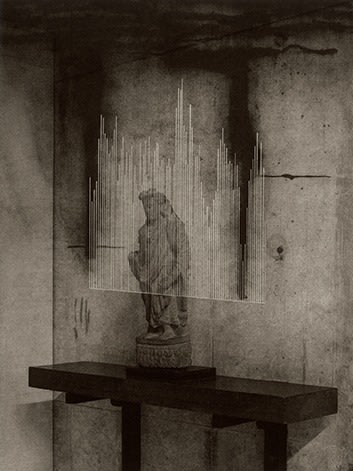
We are pleased to announce the acquisition of Seher Shah's Argument from Silence (2019) by Tate, London.
Argument from Silence is a portfolio of ten polymer photogravure prints exploring the ruptures and underlying violence in relationships between object, history, and architecture. The work explores the Gandhara sculpture from the Government Museum and Art Gallery in Chandigarh built in 1967, by working with the photographic image as a site for drawing interventions and disturbances. Gandhara, an ancient region located in present-day Afghanistan and Pakistan was transformed by the diverse, shared and accumulated knowledge of Persian, Syrian, Greek and Indian cultures. I wanted to engage with this collection as I was drawn to the relationships between object and site, and to the complex legacy of the Gandhara works.
The Partition of the sub-continent in 1947 saw the Lahore Museum’s vast collection of cultural inheritance divided between India and Pakistan. The two newly created provinces of the Punjab divided these assets of a shared cultural heritage as 15 million South Asians were displaced and more than a million killed. This collection was eventually housed in the modernist museum designed by Shiv Dutt Sharma, Manmohan Nath Sharma, Pierre Jeanneret and Le Corbusier as a site and symbol of a new capital city.
Many historical arguments and ideological ends have marked the Gandhara narrative over time, from violent and divisive colonial east-west binaries, to reductive Orientalist frameworks, and recent destructive nationalist and extremist rhetoric from Afghanistan, Pakistan and India. It was the erased and re-written histories of the sculptures and their heritage, set against the current far-right nationalist politics in the region that I wanted to reflect on.
Working with the photographer Randhir Singh, we explored how to frame the objects, not as they were conventionally displayed, but through the spaces between the sculpture and architecture. These negative spaces in-between objects, perimeter walls and corners, plinths and sculptural fragments, framed the fragile nature of the objects within the concrete museum interiors.
How the work is visually read is heavily dependent on the materiality of the print and ink itself, and the rich tonality was developed at the Glasgow Print Studio with Master Printer Alistair Gow. The printmaking process of the photogravures allowed for a material connection between the drawing and the photograph. Heavy drawing lines in oil inhabit the space of the photograph, as well as faint ghostly graphite traces from the object. The photogravure process allowed for a rich tonality of black and greys to be deposited directly onto the paper.
The title of the work comes from a phrase I read a few years ago in historian Thomas McEvilley’s essay ‘Doctor Lawyer Indian Chief, Primitivism in Twentieth Century Art, at the Museum of Modern Art in 1984’. The phrase, argument from silence, is described as ‘an attempt to prove a negative’. In the context of history, it refers to an argument made in the absence of evidence. This profound relationship of erasure, language and history has stayed with me and has found a place in this work.
Seher Shah
New Delhi, August 2019